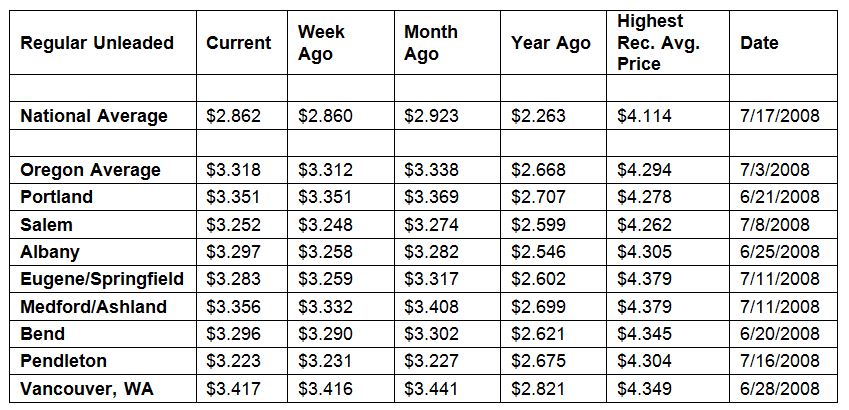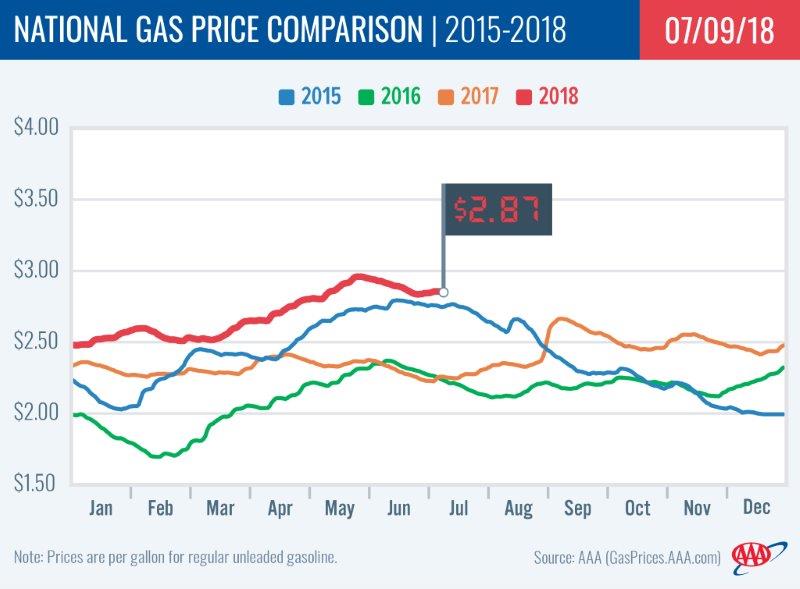PORTLAND, Ore., – Pump prices are ticking up in about half of the states this week due to strong demand and higher crude oil prices. For the week, the national average for regular holds steady at $2.85 a gallon. The Oregon average gains half a cent to $3.32.
“Demand for gasoline this summer remains very robust, driving gas prices higher along with rising crude oil prices,” says Marie Dodds, public affairs director for AAA Oregon/Idaho. The latest report from the U.S. Energy Information Administration (EIA) shows demand at 9.9 million b/d.
Oregon is one of 26 states and the District of Columbia reporting week-over-week increases. The largest are in Delaware (+9 cents) and Maryland (+3 cents). The largest weekly decreases are in Michigan (-7 cents) and New Mexico (-3 cents). This week 13 states have averages at or above $3 a gallon, same as a week ago.
Oregon is one of 46 states and the District of Columbia where prices are lower than one month ago. The national average is six cents less and the Oregon average is two cents less than a month ago. Oregon has the 43rd-largest monthly decrease in the country. New Mexico (-12 cents) has the largest monthly decrease, while Wyoming (+5 cents) has the largest monthly increase.
The West Coast continues to have the most expensive gas prices in the nation. Hawaii is most expensive for the fifth week in a row with California, Washington, Alaska, Oregon and Nevada rounding out the top six. Oregon is fifth for the third consecutive week.
| Rank | Region | Price on 7/10/18 | |
| 1 | Hawaii | $3.75 | |
| 2 | California | $3.66 | |
| 3 | Washington | $3.44 | |
| 4 | Alaska | $3.40 | |
| 5 | Oregon | $3.32 | |
| 6 | Nevada | $3.24 | |
| 7 | Idaho | $3.15 | |
| 8 | Utah | $3.15 | |
| 9 | Connecticut | $3.09 | |
| 10 | Pennsylvania | $3.04 |
Inventories of gasoline in the West Coast region fell for a third consecutive week, according to the EIA’s petroleum status report for the week ending on June 29. Dropping by nearly 150,000 bbl, total inventories now sit at 30.5 million bbl. However, inventories are approximately 2.2 million bbl higher than they were at this point last summer, which will likely help prices stabilize if there are any major supply disruptions in the region this week.
The nation’s cheapest markets are Alabama ($2.54) and South Carolina ($2.54). For the 49th week in a row, no states have an average below $2.
Drivers in all 50 states and the District of Columbia are paying more than a year ago to fill up. The national average is 60 cents more and the Oregon average is 65 cents more than a year ago. This is the 7th-largest yearly increase in the country. Arizona has the greatest year-over-year increase of 75 cents; California is second at 73 cents; Hawaii is third at 70 cents and Wyoming is fourth at 70 cents.
Oil Market Dynamics
Oil prices will likely remain volatile this week as a number of factors influence oil prices. West Texas Intermediate climbed above $74 per barrel in late June for the first time since late 2014.
Crude prices trended slightly lower last week following EIA’s report that showed U.S. crude oil inventories increased by a total of 1.3 million bbl last week. It was the first time in three weeks that the U.S. has seen a build in inventories, which typically sees drawdowns throughout the summer. At 417.9 million bbl, crude inventories in the U.S. are 85 million bbl lower than they were at this time last year.
The surprise build in total crude stocks gave market observers pause amid a slew of other factors influencing the oil market, including increasing geopolitical factors – in Iran, Libya, and Venezuela – potentially destabilizing global supply. Moving into this week, market observers will watch these factors to determine their impact on supply. If it appears that supply could be reduced amid high global crude demand, oil prices may increase.
In related news, the U.S. oil rig count increased by five last week, according to Baker Hughes, Inc., bringing the total number of rigs to 863. This is 100 more rigs than one year ago.
At the close of Friday’s formal trading session on the NYMEX, WTI increased 86 cents to settle at $73.80. At the close of Monday’s formal trading session on the NYMEX, WTI added 5 cents to settle at $73.85. Today crude is trading around $74, same as a week ago. Crude prices are up about five percent in the last month and are about $25 more per barrel than a year ago.
Drivers can find current gas prices along their route with the free AAA Mobile app for iPhone, iPad and Android. The app can also be used to map a route, find discounts, book a hotel and access AAA roadside assistance. Learn more at AAA.com/mobile.
Diesel
For the week, the national average adds half a cent to $3.17 a gallon. Oregon’s average holds steady at $3.42. A year ago the national average for diesel was $2.45 and the Oregon average was $2.65.
Find current fuel prices at GasPrices.AAA.com.
AAA news releases, high resolution images, broadcast-quality video, fact sheets and podcasts are available on the AAA NewsRoom at NewsRoom.AAA.com.



